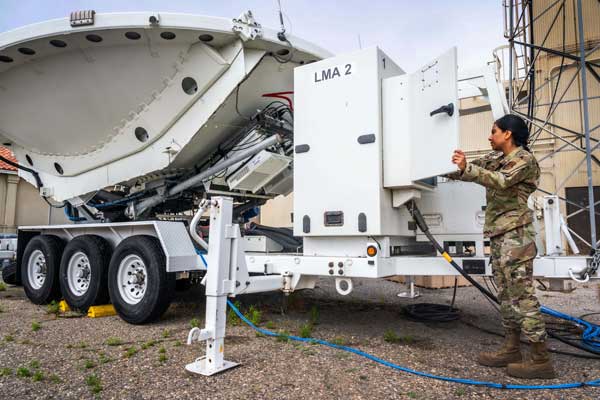
216 SPCS Enables CFSCC Mission, Assures Access to Space Through Spectrum Warfare (Image Credit: Payload)

By Tech. Sgt. Luke Kitterman
Combined Force Space Component Command
VANDENBERG SPACE FORCE BASE, Calif. – One element of warfare that is not always in the limelight but easily touches all warfighting domains is the electromagnetic spectrum. At Vandenberg Space Force Base, there resides an Air National Guard squadron that works regularly with the Combined Force Space Component Command (CFSCC) in its mission to deliver combat relevant space capabilities to combatant commanders.
The 216th Space Control Squadron (SPCS), assigned to the 195th Wing at Beale AFB, Calif., but located here, prepares its nearly 90 members, 25 of whom work full-time in the squadron, for short-notice, six-month deployments, each consisting of teams of 15-20 Airmen.
“Our battlefield is in the electromagnetic spectrum,” said U.S. Air Force Lt. Col. Robert Glas, 216 SPCS director of operations and acting commander. “We fight in the spectrum warfare.”
More important than ever due to advancements in technology, the electromagnetic spectrum includes everything from radio waves through visible light to gamma rays. According to the Department of Defense, “any military action involving the use of electromagnetic (EM) and directed energy to control the EM spectrum or to attack the enemy” is the definition of Electromagnetic Warfare (EMW).
“Vandenberg is the ‘organize, train and equip’ leg of what we do,” Glas explained. “We don’t do our actual mission from here. In order to do what we do, which is electromagnetic warfare, we have to deploy. We need to be in theater or in a region to be effective.”
To prepare for these deployments, the 216 SPCS adopted a six-day training regime every quarter, as compared to a two-day per month schedule that most ANG units have, giving them longer periods together to build cohesiveness between the 15 different career fields contained within it.
“This battle rhythm is relatively new, being implemented for about two years now, and we have seen some excellent gains from it from a readiness and training perspective,” said Glas. “It also gives us a lot of flexibility in-between quarters to provide teams and volunteers in support of other exercises and missions.”
Once in place at their deployed location, the team receives requirements and tasks from higher headquarters to conduct space control and space situational awareness missions.
In simple terms, the unit makes it harder for adversaries to gain access to their EM capabilities and assures access to EM capabilities for friendly troops and equipment, giving our warfighters and allies an advantage.
“Our capability, especially when it comes to our particular weapons system, is dual-hatted in nature,” Glas said. “Not only can we be a strategic capability, we can also be a tactical capability. We can affect an entire region if so desired by U.S. Space Command or we can affect a more-precise target. That dynamic gives us a more complicated problem to work with, but we really enjoy that challenge…having to fight in an environment that is not as well understood as other domains.”
In the past, the 216 SPCS would support whichever geographically-located commander they fell under for that area. Now, authority for many of the operations are routed back through the Combined Force Space Component Command, in the form of tactical command and control (C2) through the Combined Space Operations Center (CSpOC).
“When the 216th is here, we normally work with them on exercises and testing out processes and systems, but when they’re deployed our focus is on providing maximum space support to the warfighter,” said Col. Philip Verroco, Space Delta 5 commander and CSpOC director. “Depending on the operation, there are times where we work with them almost daily in our efforts to effectively synchronize and execute space effects for the U.S. and its allies, 24 hours a day, seven days a week.”
“The great thing about working through the CSpOC is that they are space experts who know how to utilize space assets and the 216th to meets mission requirements,” said U.S. Air Force Tech. Sgt. Josh Cheney, 216 SPCS space control operator (SCO).
Cheney occupies one of three crew positions, with the other two being a crew chief and crew commander. The crew chief checks the weapons system and makes sure it is safe while translating tasks for the SCO. The crew commander is the overall decision maker and main coordinator with higher headquarters.
“The capability we bring is not only important to Air Force assets but also to our coalition partners and joint services,” Cheney said. “Having prior service experience as a Marine provided good insight to what I am doing now and I know how critical what we do is for tactical and strategic operations.”








